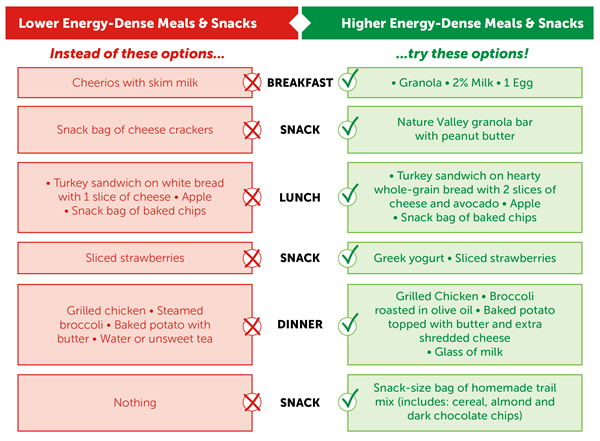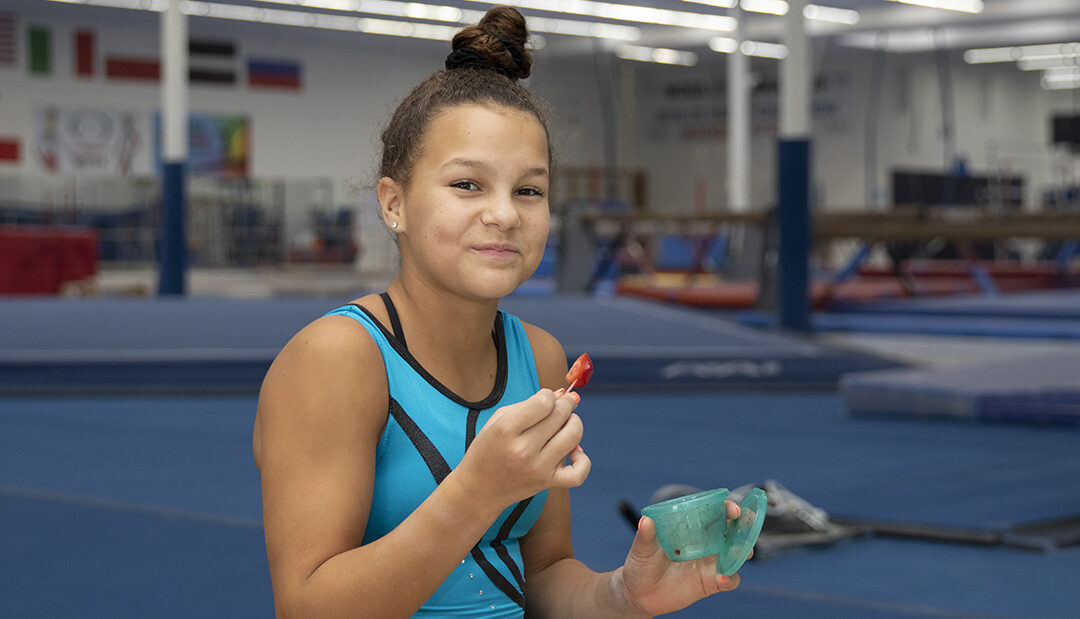Before setting any goals, it is also important to understand that young pre-pubertal athletes will not gain muscle mass like an adult because they do not yet have the level of hormones needed to support these gains. While he/she can still build muscle, the level of hormones required to support larger gains in muscle, like those often desired by young male athletes, are not present until after puberty.
When ready, here are important facts to know about how the young athlete’s nutrition can help build muscle for sport.
What builds muscle?
With the appropriate hormones present, these are necessary components for building muscle:
- Adequate calories: Getting enough calories or increasing daily calorie intake is essential to building muscle.
- Protein: Protein is the key nutrient for building muscle and should be included in all meals and some snacks.
- Carbohydrates: Carbohydrates are the main source of energy for working muscles and the brain. They should be present in all meals and snacks to provide energy and allow protein to build desired muscle mass.
- Resistance training: Exercises like lifting, pushing and pulling an outside force create necessary changes within the muscle that result in longer, stronger and bigger muscles.
Easy ways to increase calories
- Increase the number of meals or snacks eaten per day. Most young athletes need a minimum of 3 meals and 2 snacks per day.
- Add spreads to sandwiches and wraps such as avocado, hummus, pesto and mayonnaise.
- Choose heartier or thicker slices of bread.
- Include oatmeal or fresh smoothies with breakfast or snacks and add items such as milk, yogurt, peanut butter, almond butter, honey, fruit, flax or chia seeds.
- Choose nutrient-dense cereals such as: granola, Raisin Bran®, shredded wheats and Grape-Nuts®.
Ideas for increasing protein at meals and snacks
- Add an egg or Greek yogurt to breakfast.
- Choose granola bars with whole grains, nuts or seeds.
- Include a string cheese with a snack.
- Add a glass of milk or chocolate milk to meals or snacks.
- Include beans, nuts and seeds in salads.
Carbs to include with meals & snacks
- Whole-grain bagels or English muffins.
- Fresh or dried fruits.
- Starchy vegetables like white potatoes, sweet potatoes, peas, corn, winter squash.
- Rice, pasta, quinoa, couscous, etc.
- Milk or yogurt (also great sources of protein and calcium).
- Whole-grain crackers, cereals, granola bars.
Keys to Success:
- Be realistic: Young, pre-pubertal athletes will not gain muscle mass like an adult.
- Work on body composition changes during the off-season. Trying to make big changes during the season could lead to decreased performance or injury.
- Plan for gradual muscle gain. Include a well-balanced diet and a developmentally appropriate strengthening program.
- Remember, the overall goal is optimal performance. Measure improvements in performance (jumping height, running distance, etc.), not a number on the scale.
- Focus on real food: Rely on healthy, high-calorie and nutrient-rich foods instead of supplements and protein powders.
- Get enough sleep and manage stress. This is often forgotten for achieving body composition or weight goals, but it is very important.
If unsure where to start, it’s always a good idea to work with a certified sports dietitian who can help you create a plan, recommend products and support you as you work towards your goals.
Not sure if your athlete is ready to build muscle? Read “Building Muscle in Young Athletes: Getting Started”
Visit our sports nutrition page to learn more about nutrition and fueling the young athlete.
What Does a Day of Muscle Building Meals & Snacks Look Like?
Specific foods and portion sizes will vary based on an athlete’s size, age, sport and training demands.
Here is a great example. 

